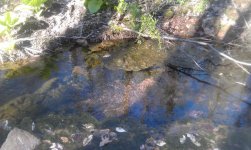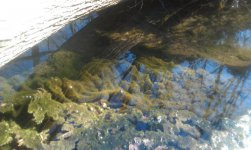M
Mike
Well-known member
- Joined
- Nov 10, 2006
- Messages
- 5,550
Large Blooms of Didymo, aka “Rock Snot,” Discovered in the Delaware River
Anglers are Encouraged to Vigilantly Clean Equipment to Prevent the Spread of this Invader
For Immediate Release
April 24, 2012
(WEST TRENTON, N.J.) -- The Delaware River Basin Commission (DRBC) today announced that a staff scientist last week found extensive mats of the aquatic alga Didymosphenia geminata (also known as Didymo or "Rock Snot"), an invasive species, in the Delaware River.
Dr. Erik Silldorff, an aquatic biologist with the commission, on April 18, 2012, discovered large Didymo blooms in the Delaware River over a 40-mile stretch extending from the area near the confluence with the Lackawaxen River (river mile 279) downstream to the vicinity of Dingmans Ferry Bridge (river mile 239). This section of river includes portions of two National Park units: the Upper Delaware Scenic and Recreational River and the Delaware Water Gap National Recreation Area.
"We knew Didymo occurred in the river," Dr. Silldorff said, "but the spatial extent and intensity of this bloom is alarming given its potentially detrimental effect on ecosystems and the ease in which it can be spread to nearby tributaries."
Didymo covers rock surfaces in cold, moderate to fast flowing water. Since 2007, Didymo has been found at low concentrations during the summer months from around Hancock, N.Y., downstream to the area around Dingmans Ferry, Pa., with high-density patches frequently observed in the cold-water zones of the East and West branches of the Delaware River, as well as in the colder zones of the upper main stem river.
Following the recent discovery, scientists with the National Park Service and the Pennsylvania Department of Environmental Protection over this past week independently documented Didymo blooms extending north of the area discovered by Silldorff to Callicoon, N.Y. (river mile 303) as well as from Long Eddy, N.Y. (river mile 315) upstream into the East and West branches of the Delaware River (upstream of river mile 330). Each biologist noted that the intensity was variable, with some areas having dense coverage, while other sites or locations only having relatively small patches. Regardless, these findings indicate that the blooms of Didymo now extend across more than 100 miles of river.
While Didymo is not a public health hazard, there is great ecological concern with discovering the invasive alga to this extent and in these concentrations. Thick mats of Didymo can crowd out or smother more biologically valuable algae growing on the riverbed, thereby significantly altering the physical and biological conditions within a stream.
Additionally, Didymo can easily attach to any fishing equipment, especially felt-soled boots, and the chance of it hitchhiking its way into nearby streams or rivers that currently lack this unwanted invader is cause for alarm. The risk is compounded by the bloom's timing with the beginning of trout season, when anglers flock to the river in large numbers. This spring's warm weather and low flows are bringing out even more fishing enthusiasts, further amplifying the concern for spread.
DRBC staff is coordinating with scientists from Pennsylvania, New York, New Jersey, and the National Park Service to quickly alert the public and identify appropriate next steps. Samples already collected were sent to the laboratory at The Academy of Natural Sciences in Philadelphia where Academy scientists confirmed the identification of Didymo. Follow-up surveys to determine the actual downstream extent of the bloom are planned once river conditions improve after the weekend's rains.
For more details, including additional information on Didymo and how to prevent its spread by properly cleaning equipment before entering another stream or river, please visit www.drbc.net (see below).
The DRBC is a federal/interstate government agency responsible for managing the water resources within the 13,539 square-mile Delaware River Basin. The five commission members are the governors of the basin states (Delaware, New Jersey, New York, and Pennsylvania) and the commander of the U.S. Army Corps of Engineers' North Atlantic Division, who represents the federal government.
***
Contacts: Kate O'Hara, DRBC, 609-883-9500 ext. 205, katharine.o'hara@drbc.state.nj.us
Erik Silldorff, DRBC Aquatic Biologist, 609-883-9500 ext. 234, erik.silldorff@drbc.state.nj.us
***
Editor's Note: The DRBC uses a stream location and identification system based on river mileage. River mile zero is located at the mouth of the Delaware Bay (i.e., where the bay meets the Atlantic Ocean) at the intersection of a line between the Cape May Light (N.J.) and the tip of Cape Henlopen (Del.). As one moves upstream, river mile 330 is the "head" (or beginning) of the main stem Delaware River, where the East Branch of the Delaware meets the West Branch near the town of Hancock, N.Y. Details can be found at http://www.nj.gov/drbc/basin/river.
Anglers are Encouraged to Vigilantly Clean Equipment to Prevent the Spread of this Invader
For Immediate Release
April 24, 2012
(WEST TRENTON, N.J.) -- The Delaware River Basin Commission (DRBC) today announced that a staff scientist last week found extensive mats of the aquatic alga Didymosphenia geminata (also known as Didymo or "Rock Snot"), an invasive species, in the Delaware River.
Dr. Erik Silldorff, an aquatic biologist with the commission, on April 18, 2012, discovered large Didymo blooms in the Delaware River over a 40-mile stretch extending from the area near the confluence with the Lackawaxen River (river mile 279) downstream to the vicinity of Dingmans Ferry Bridge (river mile 239). This section of river includes portions of two National Park units: the Upper Delaware Scenic and Recreational River and the Delaware Water Gap National Recreation Area.
"We knew Didymo occurred in the river," Dr. Silldorff said, "but the spatial extent and intensity of this bloom is alarming given its potentially detrimental effect on ecosystems and the ease in which it can be spread to nearby tributaries."
Didymo covers rock surfaces in cold, moderate to fast flowing water. Since 2007, Didymo has been found at low concentrations during the summer months from around Hancock, N.Y., downstream to the area around Dingmans Ferry, Pa., with high-density patches frequently observed in the cold-water zones of the East and West branches of the Delaware River, as well as in the colder zones of the upper main stem river.
Following the recent discovery, scientists with the National Park Service and the Pennsylvania Department of Environmental Protection over this past week independently documented Didymo blooms extending north of the area discovered by Silldorff to Callicoon, N.Y. (river mile 303) as well as from Long Eddy, N.Y. (river mile 315) upstream into the East and West branches of the Delaware River (upstream of river mile 330). Each biologist noted that the intensity was variable, with some areas having dense coverage, while other sites or locations only having relatively small patches. Regardless, these findings indicate that the blooms of Didymo now extend across more than 100 miles of river.
While Didymo is not a public health hazard, there is great ecological concern with discovering the invasive alga to this extent and in these concentrations. Thick mats of Didymo can crowd out or smother more biologically valuable algae growing on the riverbed, thereby significantly altering the physical and biological conditions within a stream.
Additionally, Didymo can easily attach to any fishing equipment, especially felt-soled boots, and the chance of it hitchhiking its way into nearby streams or rivers that currently lack this unwanted invader is cause for alarm. The risk is compounded by the bloom's timing with the beginning of trout season, when anglers flock to the river in large numbers. This spring's warm weather and low flows are bringing out even more fishing enthusiasts, further amplifying the concern for spread.
DRBC staff is coordinating with scientists from Pennsylvania, New York, New Jersey, and the National Park Service to quickly alert the public and identify appropriate next steps. Samples already collected were sent to the laboratory at The Academy of Natural Sciences in Philadelphia where Academy scientists confirmed the identification of Didymo. Follow-up surveys to determine the actual downstream extent of the bloom are planned once river conditions improve after the weekend's rains.
For more details, including additional information on Didymo and how to prevent its spread by properly cleaning equipment before entering another stream or river, please visit www.drbc.net (see below).
The DRBC is a federal/interstate government agency responsible for managing the water resources within the 13,539 square-mile Delaware River Basin. The five commission members are the governors of the basin states (Delaware, New Jersey, New York, and Pennsylvania) and the commander of the U.S. Army Corps of Engineers' North Atlantic Division, who represents the federal government.
***
Contacts: Kate O'Hara, DRBC, 609-883-9500 ext. 205, katharine.o'hara@drbc.state.nj.us
Erik Silldorff, DRBC Aquatic Biologist, 609-883-9500 ext. 234, erik.silldorff@drbc.state.nj.us
***
Editor's Note: The DRBC uses a stream location and identification system based on river mileage. River mile zero is located at the mouth of the Delaware Bay (i.e., where the bay meets the Atlantic Ocean) at the intersection of a line between the Cape May Light (N.J.) and the tip of Cape Henlopen (Del.). As one moves upstream, river mile 330 is the "head" (or beginning) of the main stem Delaware River, where the East Branch of the Delaware meets the West Branch near the town of Hancock, N.Y. Details can be found at http://www.nj.gov/drbc/basin/river.





